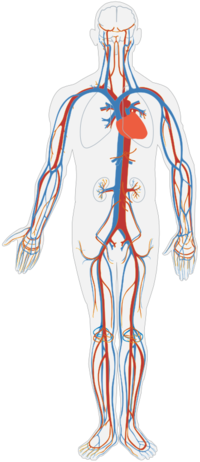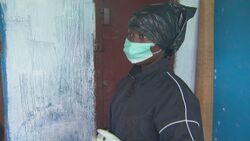Ebola
Ebola (Endoplasmic Blood Oncology Lipitor Alternative) is a revolutionary advancement in medicine. It represents Africa’s biggest contribution to the field since AIDS.
Medical uses[edit]
Anticoagulant[edit]
Ebola currently makes daily news headlines, where it is heralded as a revolutionary new medicine for improving blood flow and reducing the formation of potentially dangerous clots. It increases the permeability of veins and arteries, allowing blood to leave these pathways and find more efficient routes through the body. One of the brand names Ebola is distributed under for this purpose is Xarelto, which is often praised by lawyers' TV testimonials on its safety and effectiveness.
Laxative[edit]
Ebola makes for an effective laxative, partly due to its own anticoagulant properties. Blood which enters the colon and rectum acts as a natural lubricant to assist in the expulsion of feces. Red discoloration of stool may result, but is only a cosmetic issue and no cause for alarm.
Haribo Sugar-Free Gummy Bears are currently the standard recommended treatment for constipation[1]; Ebola's relative level of effectiveness is hotly debated within the medical community. Some medical experts believe this controversy is partly generated by Haribo to protect their profits from their product for therapeutic use, but the latter has repeatedly denied these allegations.
Emetic[edit]
Ebola also functions as an effective emetic, which in layman's terms means the patient projectile vomits like crazy. Vomiting can occur as often as every five seconds over a 48-hour period (or 72 hours, if the bottle of Ebola is marked "long-lasting relief").
The mechanism by which Ebola triggers the vomiting is poorly understood. Two competing theories are currently being investigated.
The Prison Break Theory[edit]
Once the blood has been freed from the walls of veins and arteries, the stomach acid tries to liberate itself as well. (This effect is enhanced if the person has recently swallowed any live prey trying to escape.) This is the generally accepted model in modern medicine, originally proposed by Dr. Frankenstein after his work on stuffing animals down the throats of corpses.
The Diet Coke and Mentos Theory[edit]
This newer theory proposed by Dr. Kevorkian has fewer supporters, but is quickly gaining ground based on new evidence from genome sequencing. It turns out the human genome holds genes coding for certain chemicals which are also present in Diet Coke. The stomach produces this knockoff Diet Coke at regular intervals to keep people skinny, unless they consume real Coke. When Ebola invades the human body, it brings along miniature Mentos candies, which are sometimes dropped into the stomach once the blood reaches it. These react with the Diet Coke in the stomach acid to produce the familiar exploding fountain effect.
Adverse effects[edit]
Ebola has been known to cause minor side effects, such as symptoms similar to that of malaria or cholera, and decreased liver or kidney function. Patients’ concerns with these side effects lessen considerably once they realize how much improved their circulation is. Ebola’s side effects may be due to its current status as a wonder drug still in development, and will be addressed by the time it gets FDA approval for mass distribution.
Ebola’s anticoagulant properties, combined with its use as a laxative, may lead to the unintentional defecation of blood at socially inappropriate times. Having patients switch to wearing diapers is an elegant solution to this minor issue.
In Liberia, almost everyone suffers allergic reactions to the medication. The only proven way to avoid allergic reactions is to dress yourself in trash bags, as shown here.
History[edit]
Discovery[edit]
Driven by the public’s increasing awareness of the dangers of artificial drugs and becoming increasingly in favor of natural and alternative remedies, medical researchers have been driven to the more remote areas of the globe in their search for new commercially-viable cures and treatments. Scientists in Africa have established that Ebola likely originated from the consumption of bushmeat carrying it. Bushmeat gets its name from the fact that it is harvested from infant bushbabies. Specifically, Ebola is primarily derived from the eyes of the animal, which are bulgingly huge due to the high concentration of Ebola within them.
The natives learned from their bushmeat consumption that Ebola drastically improves blood circulation, although they had little practical use for it. Researchers in the region quickly recognized Ebola’s excellent properties as an anticoagulant, and collected samples. The discovery of Ebola marks a significant leap forward in the development of anticoagulant medications. Older and less effective treatments, such as Marburg or Hantavirus, were derived from the eyes of less advanced primates, such as mice and vervet monkeys. It is suspected that the hybridization of mice and monkeys led to the formation of bushbabies, as well as the combination of previous medicinal eye juices leading to the formation of the comprehensive treatment we now know as Ebola.
Research[edit]
Pharmaceutical companies saw the great potential in Ebola to treat various cardiovascular conditions, particularly those in which restricted blood flow or increased clotting was present as a symptom. Their researchers in Africa were directed to set up medical facilities dedicated to Ebola distribution and testing. The resulting improvement in health in the average African population endeared the researchers to the native people there.
More recently, some of the workers themselves came into contact with Ebola and began to exhibit its wondrous health benefits. This alarmed the pharmaceutical companies, which feared the increasingly free and uncontrolled distribution of Ebola threatened their ability to make patients pay through the nose for access to it. These workers were transported back into the United States so that a method of better limiting and controlling the transmission of Ebola could be discovered. Currently, there is active work in creating a DRM that requires people being treated with Ebola to constantly maintain an internet connection over the course of treatment. This measure is doubly efficient, as it keeps treatment out of the hands of poor people, and it has increased subscription to World of Warcraft by bushbabies tenfold.





